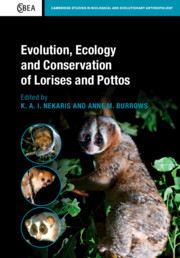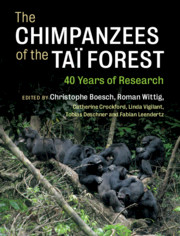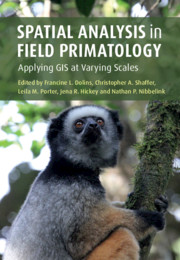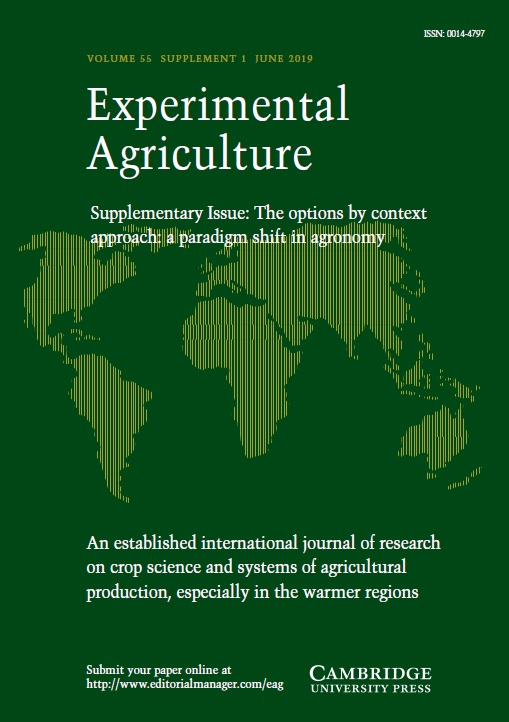Evolution, Ecology and Conservation of Lorises and Pottos
Part of Cambridge Studies in Biological and Evolutionary Anthropology
- Editors:
- K. A. I. Nekaris, Oxford Brookes University
- Anne M. Burrows, Duquesne University, Pittsburgh
- Date Published: April 2020
- availability: Available
- format: Hardback
- isbn: 9781108429023
Hardback
Other available formats:
eBook
Looking for an inspection copy?
This title is not currently available for inspection. However, if you are interested in the title for your course we can consider offering an inspection copy. To register your interest please contact [email protected] providing details of the course you are teaching.
-
Furry and wide-eyed, lorises and pottos are small, nocturnal primates inhabiting African, Asian and Southeast Asian tropical and subtropical forests. Their likeable appearance, combined with their unusual adaptations - from a marked reduction of the tail to their mostly slow, deliberate locomotion, powerful grasping and, in some species, a venomous bite - has led to a significant rise in research interest in the family Lorisidae over the last decade. Furthermore, lorises in particular have featured frequently in international media largely due to illegal trade, for example as pets. This is the first volume to present a full picture of the breadth of research being undertaken on lorisids to aid future studies as well as conservation efforts. Focusing on five key topics: evolutionary biology, ecomorphology, behavioural ecology, captive management and conservation, this book is a vital read for graduate students and researchers in primatology, biological anthropology, evolutionary biology, animal behaviour and conservation.
Read more- An overview of field methods on how to study lorisids and other primates and nocturnal mammals in the wild provides a means to make the study of nocturnal primates comparable
- Never-before-published case studies on the ecology and evolution of lorisids provides readers with meta-data analyses and a full picture of the breadth of research being undertaken
- Up-to-date taxonomy on lorisids enables accurate evolutionary and ecological interpretations, and this improved understanding aids conservation efforts
Reviews & endorsements
'As is made abundantly clear in this volume, and I know well from my own experience, nocturnal primates are never easy to study in the wild; in addition, pottos and lorises are rarely kept in captivity. Nevertheless, the editors have managed to gather together an impressive array of work from over 70 authors, covering a large number of topics ranging from the fossil record of these species to their conservation, through morphology, ecology, trade and many other subjects. In spite of all the information in this book, it also illustrates how much more research is needed on individual species in different field sites to ensure the conservation of these small, elusive, but fascinating, nocturnal creatures.' Caroline S. Harcourt, Nocturnal Primate Research Group (Oxford Brookes University) and Folia Primatologica
See more reviews'This volume provides a great deal of new information about these extraordinary primates, but even more it emphasizes how much remains to be done.' John G. Fleagle, The Quarterly Review of Biology
'This volume does rate as essential reading for anyone interested in the lorises, and the highly practically oriented conservation section for anyone with an interest in primate conservation.' Robin Crompton, The Primate Eye
Customer reviews
Not yet reviewed
Be the first to review
Review was not posted due to profanity
×Product details
- Date Published: April 2020
- format: Hardback
- isbn: 9781108429023
- length: 510 pages
- dimensions: 252 x 179 x 27 mm
- weight: 1.15kg
- availability: Available
Table of Contents
Foreword
Acknowledgements
1. Introduction: overview of lorises and pottos
Part I. Evolution, Morphology and Fossil Record:
2. Sluggards and drunkards? A history of the discovery and description of the Afro-Asian lorisidae
3. What we know (and don't know) about the fossil records of lorisids
4. Outliers: have lorisids moved beyond touch?
5. Molecular advances in lorisid taxonomy and phylogeny
6. The toothcomb of Karanisia Clarki: how does exudate-feeding fit into the ecology of this loris-like basal strepsirrhine?
7. The soft-tissue anatomy of the highly derived hand of perodicticus relative to the more generalised nycticebus
8. Making scents of olfactory sensitivity in lorises and pottos
9. Allometric and phylogenetic diversity in lorisiform orbit orientation
10. The evolution of social organisation in lorisiformes
11. Biomechanics of loris locomotion
12. What role did gum-feeding play in the evolution of the lorises?
Part II. Ecology and Captive Management:
13. Nutrition of lorisiformes
14. Seeing in the dark: visual function and ecology of lorises and pottos
15. Thermoregulation in lorises
16. Home range, activity budgets and habitat use in the Bengal slow loris (Nycticebus Bengalensis) in Bangladesh
17. Behaviour of pottos and angwantibos
18. Positional behaviour and substrate preference of slow lorises, with a case study of nycticebus Bengalensis
19. Sexual differences in feeding and foraging of released Philippine slow lorises
20. Ranging patterns of the pygmy slow loris (Nycticebus Pygmaeus) in a mixed deciduous forest in Eastern Cambodia
21. Utilising current and historical zoo records to provide insight into the captive biology of rarely kept pottos and angwantibos
22. Mother-infant behaviours in greater slow loris (nycticebus coucang) dyads consisting of mothers pregnant at confiscation and their sanctuary-born infants
23. Husbandry and reproductive management recommendations for captive lorises and pottos (nycticebus, loris, and perodicticus)
Part III. Research, Trade and Conservation:
24. Trapping, collaring and monitoring the lorisinae of Asia (loris, nycticebus) and perodicticinae (arctocebus, perodicticus) of Africa
25. Evaluation of field techniques used to assess populations of pottos and lorises
26. Occupancy modelling as a method to study slender loris density
27. Using accelerometers to measure nocturnal primate behaviour
28. Distribution and conservation status of slow lorises in Indo-China
29. Wildlife trade research methods for lorises and pottos
30. Online imagery and loris conservation
31. Slow lorises as photo props on Instagram
32. Integrating science and puppetry to inspire teenagers in rural Asia to value slow lorises
33. Developing a rescue and rehabilitation centre as a reaction to the extensive illegal wildlife trade in slow lorises
References
Index.
Sorry, this resource is locked
Please register or sign in to request access. If you are having problems accessing these resources please email [email protected]
Register Sign in» Proceed
You are now leaving the Cambridge University Press website. Your eBook purchase and download will be completed by our partner www.ebooks.com. Please see the permission section of the www.ebooks.com catalogue page for details of the print & copy limits on our eBooks.
Continue ×Are you sure you want to delete your account?
This cannot be undone.
Thank you for your feedback which will help us improve our service.
If you requested a response, we will make sure to get back to you shortly.
×







